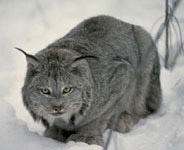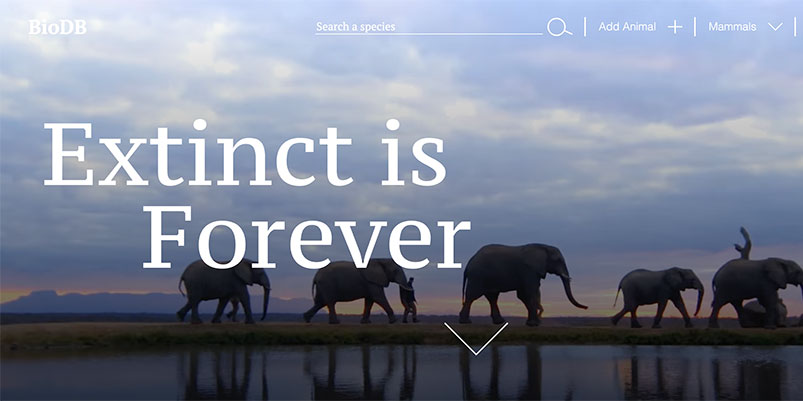Lynx Facts
Canada Lynx

Common Name: Canadian Lynx
Kingdom: Animalia
Phylum: Chordata (Vertebrata)
Class: Mammalia
Order: Carnivora
Family: Felidae
Genus: Felinae (Lynx)
Species: canadensis
Misc: The debate continues whether or not the Canadian Lynx is in fact a separate species from the Eurasian (a.k.a. Siberian or Iberian) Lynx, or merely a sub-species. Experts are evenly divided on this subject, but for now, it remains a separate species based on its marked adaptive differences for prey capture. The name Lynx comes from the Greek word “to shine,” and may be in reference to the reflective ability of the cat’s eyes.
Sub-species: L.c. subsolanus – found in Newfoundland.
Size and Appearance: The Canadian Lynx is considerably smaller than its Eurasian counterpart, approximately half the size. Its fur is usually white tipped, giving it a frosted appearance, and is only indistinctly spotted. The coat color ranges from a reddish-brown to gray, and also occurs in a rare “blue-lynx” which is the result of a genetic mutation. They have a flared facial ruff, black ear tufts, and long hind legs with a short tail. Their large, wide-spreading feet are covered in fur, which act like snowshoes, and are effective in supporting the cat’s weight on the snow. They are often confused with their smaller feline cousins the Bobcat, but can be easily distinguished by their tail tips. The tail of the Lynx looks as though it was dipped in an inkwell being black all the way around, whereas the Bobcat’s tail appears to have been painted black on top and white on the bottom.
 Habitat: These Lynx are found in the broad boreal forest belt of North America.
Habitat: These Lynx are found in the broad boreal forest belt of North America.
Distribution: Canada, Alaska, and the northern contiguous United States
Reproduction and Offspring: After a gestation of approximately 63-70 days, females produce a litter of 1-8 kittens, with the average varying depending on the abundance of prey. They weigh 7-7.5 ounces at birth and will open their eyes at around 10-17 day, and begin to walk between 24-30 days. They are weaned between 3-5 months of age, and reach sexual maturity around 23 months. The number of offspring is directly related to the abundance of prey, as is the age of sexual maturity. When prey is very abundant, females will breed as early as 10 months.
In the wild, Canadian Lynx have lived up to 15 years, and in captivity, up to 21.
Social System and Communication: Solitary, except for females with offspring, or siblings who have just separated from their mothers who may travel and hunt together for several months before separating.
Hunting and Diet:  Unlike any other cat – this Lynx depends solely and almost exclusively, on the snowshoe hare. No other predator has such a strong cyclic prey base to which it has become uniquely adapted – both behaviorally and physiologically. The snowshoe hare population peaks every 10 years, and with it, so does the lynx population. When the hare population decreases, so does the lynx population. While Lynx will change their prey base when hares are low to include small rodents, ground birds, and small ungulates, the overall Lynx population is still synchronous with the hare population.
Unlike any other cat – this Lynx depends solely and almost exclusively, on the snowshoe hare. No other predator has such a strong cyclic prey base to which it has become uniquely adapted – both behaviorally and physiologically. The snowshoe hare population peaks every 10 years, and with it, so does the lynx population. When the hare population decreases, so does the lynx population. While Lynx will change their prey base when hares are low to include small rodents, ground birds, and small ungulates, the overall Lynx population is still synchronous with the hare population.
Principal Threats: Trapping continues to be one of the greatest threats for the Lynx, and as Lynx are easily trapped, when done during times of low numbers it makes recovery of the population extremely difficult. As is with every other feline population, these too face habitat loss due to destruction by humans. However bleak this sounds, the outlook for the Canadian Lynx is better and more promising than it is for many of the other feline species. Human kill over 11 million rabbits each year according to statistics provided from hunting license sales and kill reports. The snow shoe hare is the primary staple of the Canadian Lynx but due to over hunting their food supply is diminished. Hunters only comprise 6% of our population, but they kill over 100 million animals each year for sport.
Status: CITES: Appendix II. IUCN: Not listed. Threatened as of 2000.
Felid TAG 2003 Recommendation: Canadian lynx (Lynx canadensis). Common in Canada and Alaska, this species is included in the RCP because of its educational and exhibitory value, especially for North American themes. The continental USA population has been proposed for threatened or endangered status by the U.S. Fish and Wildlife Service since the 1970’s but have been denied protection because it would interfere with road construction and logging in their territory. The present zoo population is considered too large, and the TAG recommends a reduction to a total of no more than 80 individuals. A regional studbook and a PMP management plan are recommended. The first stud book ever was published for this species in 2003.
How rare is this cat? The International Species Information Service lists 70 worldwide, with 34 being in the U.S.
Information reprinted With Permission from the IUCN Wild Cats Book.
See Conservation Work Funded By Big Cat Rescue here:
All conservation insitu work: https://bigcatrescue.org/insitu/








ALL LYNX SPECIES SHOULD HAVE FEDERAL PROTECTIONS ON THEM
i am doing a report on the lynx and i really want to help ensure that the lynx does not go extinct because of hunters
i dont think we will see lynx in the next 50 years
this wildcat is about to be Endangered and hope we can do alot to save it
btw thanks for facts 🙂
Can’t they be reintroduced to the wild in Canada?
They could be and I m sure they are maybe it is just not mentioned in this passage. Or maybe that cant happen. I mean don’t you have to have babies to release into the wild first?
Does anyone know why these predatory cats have a ruff around the neck?
The ruff is supposed to keep them warm, also this is useless as it is 6 years later
Maybe it depends on which end of the cat they are looking at. The back legs are long and the front legs are shorter, but overall, their legs are pretty long in comparison to their bodies.
Please reply to me I’m a student of kca nova scotia in canada and I have a project on canada lynx and I’d like to help these lynx and put up posters and I just want to help. E mail me @ sjg990590@gnspes.ca
I am doing a reserch paper on the canadian lynx and I was wondering if you might understand why some sources say that they have short legs and some say that they have long legs?
Had you ever thought to groom them when they get dreads? I know grooming isn't natural but I am sure they would feel better. When a domestic cat can't groom properly it will get depressed. Is it the same for larger cats?
Sedation is very dangerous to exotic cats. Sometimes they don't wake up at all. It builds up in their kidneys over the years and kills them by the time they are 12 or so. We only do a grooming job while they are out for some other life threatening procedure and that's why our cats live into their late teens and early 20s.
lynz word can translate to Greek but I love cats it’s so cute
Hi my name is Joseph I am doing a school project on lynx and I was wondering if you could help me maybe send me facts about them thank you if you read this please reply!
such a beautiful cat! what a shame that they are hunted for fur.